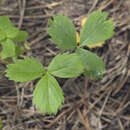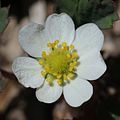mk
имиња во трошки


Fragaria iinumae (lat. Fragaria iinumae) — gülçiçəyikimilər fəsiləsinin çiyələk cinsinə aid bitki növü.
Fragaria iinumae (lat. Fragaria iinumae) — gülçiçəyikimilər fəsiləsinin çiyələk cinsinə aid bitki növü.
Fragaria iinumae is a species of strawberry native to Japan and eastern Russia.[1][2][3]
In Japan it was first discovered on Mount Nōgōhaku (能郷白山, Nōgōhaku-san) and the name Nōgō Fragaria (ノウゴウイチゴ・能郷苺, Nōgō Ichigo) was given.[4][5]
All strawberries have a base haploid count of 7 chromosomes. Fragaria iinumae is diploid, having 2 pairs of these chromosomes for a total of 14 chromosomes.[1][2][3] Fragaria iinumae is one of the diploid progenitors of the octoploid strawberry.[6]
Fragaria iinumae is a species of strawberry native to Japan and eastern Russia.
In Japan it was first discovered on Mount Nōgōhaku (能郷白山, Nōgōhaku-san) and the name Nōgō Fragaria (ノウゴウイチゴ・能郷苺, Nōgō Ichigo) was given.
All strawberries have a base haploid count of 7 chromosomes. Fragaria iinumae is diploid, having 2 pairs of these chromosomes for a total of 14 chromosomes. Fragaria iinumae is one of the diploid progenitors of the octoploid strawberry.

Flower

Fruits

Montage
Fragaria iinumae es una especie de frutilla nativa de Japón y este de Rusia.[1][2][3] Su fruto tiene débil sabor, y no comercial.
Al contrario de la mayoría de las frutillas con una base haploide de 7 cromosomas, Fragaria iinumae es diploide, con 2 pares de esos cromosomas con un total de 14 cromosomas.
Fragaria iinumae fue descrita por Tomitarô Makino y publicado en Bot. Mag. (Tokyo) xxi. 156 (1907).[4]
Fragaria: nombre genérico que proviene del latín fraga, "fresa", que se deriva de fragum, "fragante", donde se refiere a la fragancia de la fruta.[5]
Fragaria iinumae es una especie de frutilla nativa de Japón y este de Rusia. Su fruto tiene débil sabor, y no comercial.
Al contrario de la mayoría de las frutillas con una base haploide de 7 cromosomas, Fragaria iinumae es diploide, con 2 pares de esos cromosomas con un total de 14 cromosomas.
Fragaria iinumae est une espèce de fraisiers originaire du mont Nōgōhaku au Japon et de Sakhaline (Russie). C'est une espèce diploïde (2n = 2x = 14). Elle est nommée ainsi en l'honneur du botaniste japonais, Iinuma Yokusai.
Fragaria iinumae est une espèce de fraisiers originaire du mont Nōgōhaku au Japon et de Sakhaline (Russie). C'est une espèce diploïde (2n = 2x = 14). Elle est nommée ainsi en l'honneur du botaniste japonais, Iinuma Yokusai.

ノウゴウイチゴ(能郷苺、学名:Fragaria iinumae Makino)は、バラ科オランダイチゴ属に分類される多年草の1種。別名、ノウゴイチゴ[1]。高山植物。
茎は肥厚した根茎から匍匐枝を長く伸ばし、地を這う。葉は根生し、長い葉柄をもった3小葉からなる。小葉は倒卵形で長さ15-30mm、縁にはあらい鋸歯があり、裏面は粉白色を帯びる。葉裏、葉柄、花茎に伏毛がある。
花期は6-7月。細い花茎の先端に数個の花をつける。花は白色で径15-25mm、幅が狭い花弁は7-8個で、萼片も7-8個になる。雄蕊は黄色で長さ2mmになる。果実(果床)は7-8月に径8mmの卵形になり、赤熟し、食用になる。
サハリンと日本に分布する[1]。基準標本は、日本中北部の高山のもの[1]。
日本では、北海道および本州の北部から伯耆大山にかけた日本海側に分布し、高山から亜高山の湿り気のある草地に生育する。和名は、江戸時代の医家で本草学者の飯沼慾斎が『草木図説』において、岐阜県本巣市の能郷白山に生育することを記したことからつけられた。